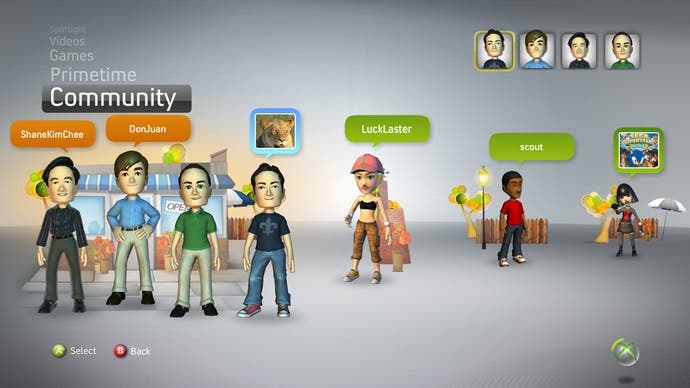The New Xbox Experience: Avatars
Rare shows off its new threads.
In hindsight - particularly in light of Sony's occasionally cringe-worthy PlayStation Home demonstration the year before, when Jack Tretton showed us his "tricked-out apartment" and Kaz Hirai addressed us from a virtual balcony - introducing The New Xbox Experience with a party of executive E3 Avatars was a gutsy move.
But as the digital Shane Kim knelt and beamed and virtual Don Mattrick rocked a cocksure pose with hands on his hips, the leafy corner of the UK where the electronic execs had been pieced together was quietly confident. At their desks in one of Rare's Twycross "barn" studios, no doubt, Avatars product manager Chris Sutherland and head of art Lee Musgrave were witnessing the culmination of weeks of planning and emails back and forth perfecting the look.
"There was a little bit of that on a couple of those," says Musgrave, as we go through a fuller Avatars demo a few weeks later when the dust's settled. Classic Microsoft: months of approval. "Where's the hairline? How big is my waist? I'm taller than that! All those kind of things." He won't name names. "All of those characters were built from assets that are part of this kit, so although they were actually characters we rendered out through a 3D application for promo purposes, it's all stuff that you could build with the assets in here."
Avatars, officially announced at E3 but clumsily outed a few weeks previously in the great Intellisponse implosion of mid-June, are Microsoft's answer to Nintendo Miis, PlayStation Home's player models and the characters wandering the massively-multiplayer virtual desert of Second Life, and despite decades of experience crafting interfaces in Redmond, the Xbox platform holder decided to turn to its expensive countryside gaming acquisition of a few years previously for design and implementation. "In terms of Rare being involved in this project, I think it was a very specific decision on Microsoft's part to get us involved," says Musgrave.
"We have the ability to develop multiple things at once. So there's an opportunity for us to use this in a very close-knit way with our own team to develop stuff, and that leads onto the fact we can then use those games as a testing bed to make the use of the Avatars for developers very simple. I think that's one reason why we got the nod to do this stuff. People like Scene It [one of the games that will use Avatars], for example, we've given a blob of stuff to them and it's been very simple for them to put Avatars into their game."

From an end-user perspective, though, Avatars are still untried. The Microsoft execs didn't make their own, after all. So apart from checking out Banjo-Kazooie: Nuts & Bolts and Viva Piñata: Trouble in Paradise, we've travelled 90 minutes north of London to dig into the process. The most important thing to note, first of all, is that Avatars are an obligatory but easily dodged initial step in the New Xbox Experience. "When you create a new profile or sign in with an existing profile on the new dashboard, you're presented with the ability to make an Avatar," says Chris Sutherland, pad in hand, and if you can't be bothered, three clicks is all it takes to pick a random model and forget about it.
The same goes for people who don't want to dig down into it. Hit a button and ten random Avatars trot merrily onto the screen, and you can pick a favourite or hit another button to cycle in another random ten. Sometimes, says Sutherland, this is enough for anyone: Avatars are a simplified take on human characteristics, so even the randomers throw up the odd recognisable character. "Bald people tend to remind me of J Allard, but I don't know why," says Sutherland. Nostalgia, perhaps.
Starting either with a basic template or borrowing a randomer, users who do want to delve deeper can then start modifying in front of a virtual mirror. As with Banjo, which sports a vehicle editor, Rare's been cautious about this process. "If you give people too much creativity, it breaks things," Musgrave acknowledges. "Especially since we want that balance between something creative and not having it so you can touch every parameter to the nth degree - approachable and simple enough to get what you want and not overwhelm people."
Most people start with the hair, says Sutherland. "Hairstyles is the one thing we found people wanted more of, because it really identifies them. In some of the tests we ran, women in particular pick the hairstyle and say 'that's me', so we want as many as we can." There's a grid of various hairstyles, and you can move between pages and pages of examples. Interestingly, once Sutherland cycles the skin colour, the faces beneath the hair on the grid change to reflect this. "This is one of the ways we're differentiated from other systems," he says, no doubt referring to Nintendo's Miis, which use outlines and require a bit of experimentation. Here you can see at-a-glance exactly how the end result will look. It's a similar process for eyes, chins and brows, rather than a mass of slider bars.

